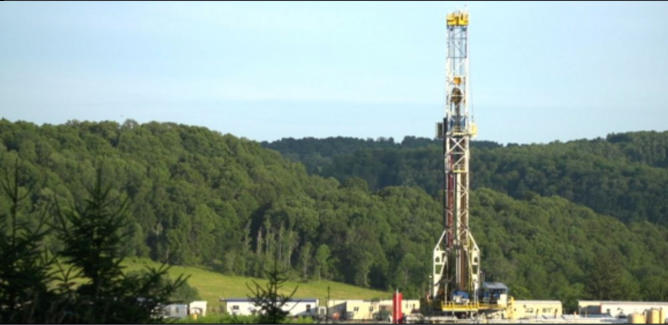

The mission of Our Water, Our
Air, Our Rights is to help people
protect their right to clean air,
pure water, and to the preser-
vation of the natural, scenic,
historic and esthetic values of the
environment. We acknowledge
that Pennsylvania's public natural
resources are the common
property of all the people,
including generations yet to
come. Our Water, Our Air, Our
Rights, through its educational
programs and other actions, shall
strive to preserve and protect
these rights for the benefit of all
the people.

Details About The Local Impacts of Fracking
“Conventional” vertical gas well drilling has been done in a safe and environmentally sound manner for generations. Hydraulic fracturing was first used in these vertical wells over fifty years ago to fracture short vertical distances of shale layers to extract more gas, but this technique used minimal pressures and only a few hundred gallons of water. These vertical well drilling operations take only a week or two to complete. “Unconventional” horizontal gas well drilling uses a vastly different technology first drilling vertically between 4,000 and 7,000 feet to the depth of the fossil shale layer, then turning the drill bit horizontally following the shale layer for up to 5 miles. Well pipes or casings are inserted into the well hole, and then explosive charges perforate the casings in the shale layer to later allow the fracking fluid to enter the shale. The drilling tower is in place for 3 – 5 months for these activities which operate round the clock, 24 hours a day, 7 days a week, and require bright area lights for safety. The drilling noise, truck noise and lights affect the animals and neighbors within several miles of the drill site. Then to begin the fracking operations, the tower is removed, and 6 to 8 diesel-electric generators on semitractor trailers are brought in near the well borehole, along with 4 – 6 hydraulic pump trucks and 8 – 10 large water containers, all connected with pipes to the well head flow-back valve to commence the actual fracking operations. The high-pressure pumps generate hydraulic pressures of 10,000 – 25,000 psi to pump the fracking fluid into the well. The fracking fluid is comprised of 3 - 5 million gallons of fresh water mixed with fine dust-like fracking sand and over 50 different chemicals, some very toxic, for each of the 2 to 5 mile-long horizontal wells. (Up to 6 or 8 different wells can be drilled on each drilling pad.) This high-pressure fracking activity can continue for 2 – 3 months until the shale layer is sufficiently fractured to release the natural gas. Then the pumps are disconnected, and preparations are made to accept the flow-back water and the natural gas. Over a million gallons of this toxic flow-back water is regurgitated back out of each well leg when pressure is relieved and gas starts flowing, bringing with it other harmful elements from the earth such as radon, cesium and radium. This “frack” water is stored in temporary ponds or tanks until it can be removed from the site by hundreds of tank truck trips. The natural gas is directed to flaring towers, and burned off until the flow-back water stops coming out of the well in a few weeks, and the natural gas is then either connected to compressor stations for processing, metering and distribution to natural gas distribution pipelines, or simply capped-off until the distribution pipelines are available. These fracking operations continue 24/7 for 2-4 months for each well drilled, and the compressor and pumping noise, truck noise and lights continue to affect the animals and neighbors within several miles of the drill site. The area groundwater that nearby residents depend on for drinkable well water can become contaminated by well casing failures or unexpected flow via fissures developed in the different geological layers up to near the surface. Pond evaporation and spills can cause both soil and stream contamination as well as airborne contamination. This wastewater is not accepted at water treatment facilities, and is often pumped back into the earth at great depths into new “injection” wells, creating minor earthquakes in these regions. These undesirable immediate consequences of fracking on the local residents have been growing in numbers, and long-term health effects are now being documented and studied. Increased incidence of rare cancers, birth defects and heart conditions are some of these new conditions attributed to fracking. The small local communities see an increase in the local economy for a short while because the “boom town” effect of the large numbers of transient workers and truck drivers, but these communities also see an increase in the crime rate. Then when an area is “fracked-out,” the local economy and un-fracked land values plummet. The few well site landowners may see financial gains of tens of thousands of dollars/per month in royalties if their contracts hold up, while their neighbors suffer property losses. In addition, fracked well production drops over time and re-fracking may be needed with all the disturbances that that entails. Finally, the number of compressor stations and pipelines in rural Pennsylvania will have to more than double to carry this glut of natural gas to coastal ports for shipping overseas as liquid natural gas, bringing new risks and causing more environmental and property damage. We need to end this era of natural gas development. GLOBAL IMPACTS: “Natural Gas” is predominantly methane gas, and when released unburned it contributes greatly to the greenhouse gas layer that produces global warming and climate changes. When burned for energy it generates carbon dioxide as any fossil fuel does, also adding to the green house gas effect. In this new era of cooperation with and assistance to the developing countries in the world, the new distribution grids needed for clean energy are different, because the energy is generated and distributed in many locations. This greatly reduces the average distance from the generation location to the end user, saving costs, energy transmission losses, and environmental damage. As more and more clean energy generation comes on line here in the U.S., the modernization and updating of our power grid will also see cost and environmental benefits. At this time when most large energy–consuming countries are investing in new clean energy sources of power such as wind, solar and geothermal, it is counterproductive for the U.S. to invest in new infrastructure for the gas/fossil fuel industry when it is destined to be phased out. The long-term effects of global warming and climate change are now becoming known as critical for survival of life as we know it.
Fracking Details

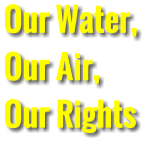

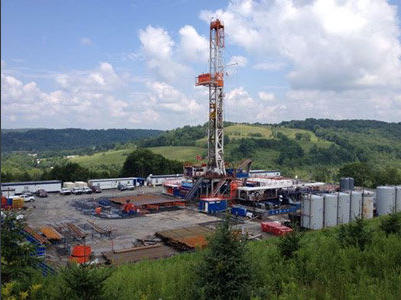
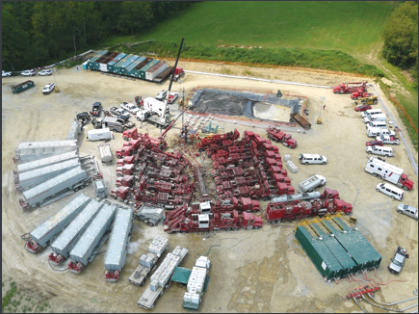
Photo by Paulio Shakespeare

The mission of Our Water, Our Air, Our Rights is to help
people protect their right to clean air, pure water, and to the
preservation of the natural, scenic, historic and esthetic
values of the environment. We acknowledge that
Pennsylvania's public natural resources are the common
property of all the people, including generations yet to come,
Our Water, Our Rights, through its educational programs
and other actions, shall strive to preserve and protect these
rights for the benefit of all the people.

Details About The Local Impacts of
Fracking
“Conventional” vertical gas well drilling has been done in a safe and environmentally sound manner for generations. Hydraulic fracturing was first used in these vertical wells over fifty years ago to fracture short vertical distances of shale layers to extract more gas, but this technique used minimal pressures and only a few hundred gallons of water. These vertical well drilling operations take only a week or two to complete. “Unconventional” horizontal gas well drilling uses a vastly different technology first drilling vertically between 4,000 and 7,000 feet to the depth of the fossil shale layer, then turning the drill bit horizontally following the shale layer for up to 5 miles. Well pipes or casings are inserted into the well hole, and then explosive charges perforate the casings in the shale layer to later allow the fracking fluid to enter the shale. The drilling tower is in place for 3 – 5 months for these activities which operate round the clock, 24 hours a day, 7 days a week, and require bright area lights for safety. The drilling noise, truck noise and lights affect the animals and neighbors within several miles of the drill site. Then to begin the fracking operations, the tower is removed, and 6 to 8 diesel-electric generators on semitractor trailers are brought in near the well borehole, along with 4 – 6 hydraulic pump trucks and 8 – 10 large water containers, all connected with pipes to the well head flow-back valve to commence the actual fracking operations. The high-pressure pumps generate hydraulic pressures of 10,000 – 25,000 psi to pump the fracking fluid into the well. The fracking fluid is comprised of 3 - 5 million gallons of fresh water mixed with fine dust-like fracking sand and over 50 different chemicals, some very toxic, for each of the 2 to 5 mile- long horizontal wells. (Up to 6 or 8 different wells can be drilled on each drilling pad.) This high-pressure fracking activity can continue for 2 – 3 months until the shale layer is sufficiently fractured to release the natural gas. Then the pumps are disconnected, and preparations are made to accept the flow-back water and the natural gas. Over a million gallons of this toxic flow-back water is regurgitated back out of each well leg when pressure is relieved and gas starts flowing, bringing with it other harmful elements from the earth such as radon, cesium and radium. This “frack” water is stored in temporary ponds or tanks until it can be removed from the site by hundreds of tank truck trips. The natural gas is directed to flaring towers, and burned off until the flow-back water stops coming out of the well in a few weeks, and the natural gas is then either connected to compressor stations for processing, metering and distribution to natural gas distribution pipelines, or simply capped-off until the distribution pipelines are available. These fracking operations continue 24/7 for 2-4 months for each well drilled, and the compressor and pumping noise, truck noise and lights continue to affect the animals and neighbors within several miles of the drill site. The area groundwater that nearby residents depend on for drinkable well water can become contaminated by well casing failures or unexpected flow via fissures developed in the different geological layers up to near the surface. Pond evaporation and spills can cause both soil and stream contamination as well as airborne contamination. This wastewater is not accepted at water treatment facilities, and is often pumped back into the earth at great depths into new “injection” wells, creating minor earthquakes in these regions. These undesirable immediate consequences of fracking on the local residents have been growing in numbers, and long-term health effects are now being documented and studied. Increased incidence of rare cancers, birth defects and heart conditions are some of these new conditions attributed to fracking. The small local communities see an increase in the local economy for a short while because the “boom town” effect of the large numbers of transient workers and truck drivers, but these communities also see an increase in the crime rate. Then when an area is “fracked-out,” the local economy and un-fracked land values plummet. The few well site landowners may see financial gains of tens of thousands of dollars/per month in royalties if their contracts hold up, while their neighbors suffer property losses. In addition, fracked well production drops over time and re-fracking may be needed with all the disturbances that that entails. Finally, the number of compressor stations and pipelines in rural Pennsylvania will have to more than double to carry this glut of natural gas to coastal ports for shipping overseas as liquid natural gas, bringing new risks and causing more environmental and property damage. We need to end this era of natural gas development. GLOBAL IMPACTS: “Natural Gas” is predominantly methane gas, and when released unburned it contributes greatly to the greenhouse gas layer that produces global warming and climate changes. When burned for energy it generates carbon dioxide as any fossil fuel does, also adding to the green house gas effect. In this new era of cooperation with and assistance to the developing countries in the world, the new distribution grids needed for clean energy are different, because the energy is generated and distributed in many locations. This greatly reduces the average distance from the generation location to the end user, saving costs, energy transmission losses, and environmental damage. As more and more clean energy generation comes on line here in the U.S., the modernization and updating of our power grid will also see cost and environmental benefits. At this time when most large energy–consuming countries are investing in new clean energy sources of power such as wind, solar and geothermal, it is counterproductive for the U.S. to invest in new infrastructure for the gas/fossil fuel industry when it is destined to be phased out. The long-term effects of global warming and climate change are now becoming known as critical for survival of life as we know it.
Fracking Details

Our Water, Our Air, Our Rights

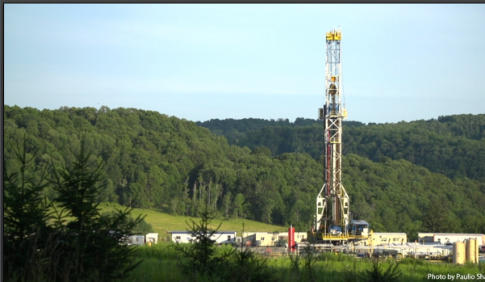
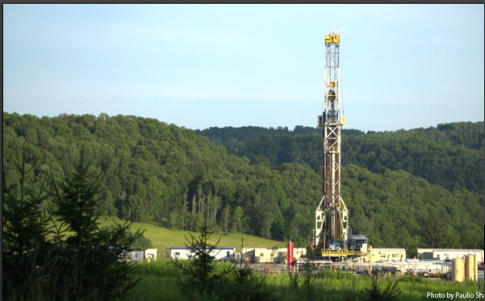
Photo by Paulio Shakespeare



















